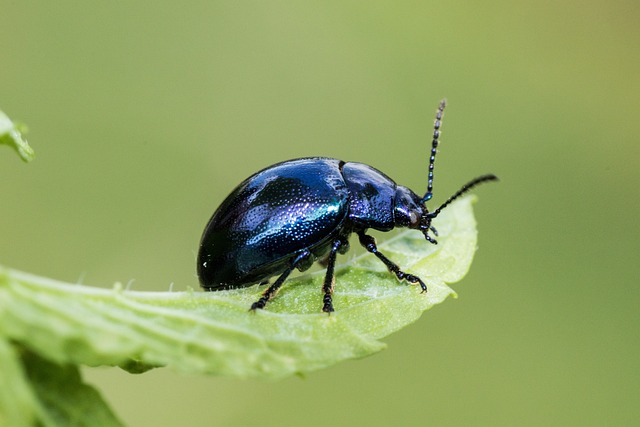Carpet beetles, feeding on natural fibers, cause damage through holing and discoloration. Eco-friendly solutions include plant-based insecticides, regular vacuuming, good hygiene, lavender, cedarwood oil, tea tree oil, diatomaceous earth, neem oil, dehumidifiers, HEPA filters, and airtight storage. Natural remedies and biodegradable insecticides target specific pests safely. Comprehensive eco-friendly carpet beetle solutions protect furniture and fabrics through regular cleaning, eco-friendly products, and airtight containers.
Unwanted carpet beetles can cause significant damage to your home’s textiles, but targeted treatments offer effective protection. This comprehensive guide explores various methods to safeguard carpets, furniture, and fabrics from these pesky intruders. From understanding the different types of carpet beetles and their destructive habits to discovering powerful eco-friendly prevention techniques, you’ll learn how to create a robust defense system. We also delve into natural remedies and chemical options for targeted treatments, ensuring your home remains beetle-free with minimal environmental impact.
Understanding Carpet Beetles: Types and Damage They Cause
Carpet beetles are a common household pest that can cause significant damage to carpets, fabrics, and furniture. Understanding these tiny invaders is crucial when seeking effective treatment methods. There are several types of carpet beetles, each with its own unique characteristics and preferred feeding grounds. Common species include the wool carpet beetle, the case-bearing carpet beetle, and the fur or fabric beetle. These beetles often feed on natural fibers like wool, silk, cotton, and linen, making fabrics and carpets their favorite targets.
The damage caused by carpet beetles can range from noticeable holes in fabrics to discolored and damaged carpets. They spin silken webs or create cases to protect themselves while feeding, leading to visible signs of infestation. Eco-friendly carpet beetle solutions are available for those seeking natural alternatives. These methods often involve using plant-based insecticides, regular vacuuming, and maintaining good hygiene to disrupt the beetles’ life cycle and prevent future infestations.
Eco-Friendly Prevention Methods for Carpet Beetle Infestations
To prevent carpet beetle infestations, consider adopting eco-friendly methods that promote a healthy and clean environment. Regular vacuuming with a high-efficiency particulate air (HEPA) filter can effectively remove adult beetles and larvae before they reproduce. Maintaining low humidity levels in your home is also crucial; carpet beetles thrive in moist environments, so using dehumidifiers or ensuring proper ventilation can significantly deter them.
Using natural repellents like lavender, cedarwood oil, or tea tree oil can provide an extra layer of protection. These essential oils can be diffused or applied to vulnerable areas like carpets and fabrics. Moreover, regularly cleaning and sanitizing your home, especially high-risk zones, will minimize the presence of food sources that attract carpet beetles. Opting for these eco-friendly prevention methods not only keeps your living spaces safe but also contributes to a healthier planet.
Targeted Treatments for Carpets: Natural Remedies and Chemical Options
Carpet pests, such as carpet beetles, can be a nuisance, but there are various targeted treatments available to address them effectively while minimizing environmental impact. When it comes to eco-friendly carpet beetle solutions, natural remedies offer a gentle approach. Essential oils like lavender, tea tree, and eucalyptus possess insecticidal properties and can be used in combination with other natural ingredients like diatomaceous earth or neem oil. These methods are safe for both carpets and the environment, making them ideal choices for those concerned about chemical exposure.
For a more robust solution, chemical options also exist, but it’s crucial to opt for environmentally friendly formulations. Modern insecticides designed for carpet beetles are made from biodegradable compounds that target specific pests without harming fabrics or leaving harmful residues. These chemicals can be applied directly to affected areas or used in spray form, ensuring quick relief while maintaining sustainability.
Extending Protection to Furniture and Fabrics: A Comprehensive Approach
Extending protection to furniture and fabrics is a crucial aspect of maintaining a clean and healthy living environment, especially in areas prone to pest infestations. When it comes to eco-friendly carpet beetle solutions, a comprehensive approach is essential. This involves not just treating the carpets but also implementing strategies to safeguard furniture and fabrics from these tiny invaders.
One effective method is regular cleaning and vacuuming to remove dust and debris, which often attract beetles. Using eco-friendly cleaning products further reduces the risk of pest infestation by minimizing the use of harsh chemicals that can leave residues on surfaces. Additionally, storing items in airtight containers, particularly for fabrics like curtains or upholstery, can significantly deter beetles from laying eggs. This multi-faceted approach ensures a lasting solution, promoting a peaceful coexistence between residents and these tiny critters while preserving the quality and longevity of furniture and fabrics.
In conclusion, addressing carpet beetle infestations requires a multi-faceted approach. By understanding the different types and their damage potential, implementing eco-friendly prevention methods, and utilizing targeted treatments for carpets, furniture, and fabrics, you can effectively protect your space from these pests. Remember that choosing the right solution, whether natural remedies or chemical options, depends on the specific needs and preferences of your environment, with an emphasis on selecting eco-friendly carpet beetle solutions whenever possible.
